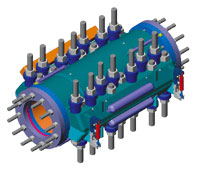 Technology from Europe: Technology from Europe:
United Kingdom
Pipeline contingency planning can save money
Leak-sealing repair clamps have traditionally been ordered and supplied when the need arises, but valuable time and cost can be saved by holding one or more clamps as a contingency against pipeline accidents.
 |
The cross-asset clamps use split sleeve fitting that can be applied to any section for repair or reinforcement while pipeline operation continues.
|
|
Cumbria-based Furmanite’s latest self-sealing clamps are designed to accommodate variations in outside diameters and out-of-roundness. These “cross-asset” clamps have been introduced in the North Sea, and are stimulating interest in the Caspian, Far East and Gulf of Mexico.
An exact fit on a high-pressure line is crucial to avoid extrusion and to maintain the seal. If the clamp is too large, the seal will be forced out under pressure, due to the void between pipe and clamp. These scaleable clamps use a system of interchangeable inserts and seals to accommodate an outside diameter variation of more than 30 mm.
The clamps use split-sleeve fitting that can be applied to any section for repair or reinforcement while pipeline operation continues. No sealing compound injection is required; instead, flouro-elastomer rubber seals are compressed and loaded by bolting around each end of the clamp and between the clamp halves, producing an effective, mechanically actuated seal.
The circumferential seals are loaded in the axial direction and activated using a separate flange or glanded arrangement at each end of the clamp, which causes radial expansion and compression against the pipe surface.
Key to the cross-asset clamps are the inserts, which come in varying sizes, so that a single clamp can accommodate pipe size variations. The inserts create an anti-extrusion system to prevent pressure from pushing out the seals. They slide on tapers to span the annulus between the outside of the pipe and inside of the clamp. As they slide inwards, they accommodate the pipe diameter. The near-tangential bolting is torqued to load the seal, limit bending and distortion and maintain the seal.
Two seal sets are used. An installation can be proven before repressurizing the pipe by pressurizing the space between the two seals. This does not subject the pipe itself to additional loading or pressure. The dual seal also allows periodic retesting to confirm seal integrity during the 25-yr design life of the clamps. Sacrificial anodes provide cathodic protection.
Finite element analysis and cast steel bodies enable optimum use of materials and minimize overall weight, while retaining the shell thickness and bolting requirements for high pressures.
The company first designed and built cross-asset clamps for BP’s use in the North Sea. The company has now provided clamps for high-pressure deployment in 8-, 14-, 16- and 24-in. sizes. A number of cross-asset clamps have been supplied to the Azerbaijan International Operating Company.
Cross-asset clamps have been designed in sizes from 8 to 36 in. and tested to pressures over 400 bar. 
|

 Technology from Europe:
Technology from Europe:

